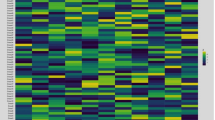Abstract
Understanding the genetic basis of biochemical traits of different cauliflower genotypes is essential for planning the effective breeding strategies in genetic improvement. To determine the mode of inheritance of dry matter content and biochemical traits, we made crosses using four genotypes of cauliflower, and obtained \(\hbox {F}_{1}\), \(\hbox {F}_{2}\), \(\hbox {BC}_{1}\) and \(\hbox {BC}_{2}\) populations. The six generations obtained were replicated thrice and evaluated in a randomized block design. The generation mean analysis of data showed the presence of duplicate epistasis in dry matter content which suggested the adoption of reciprocal recurrent selection and biparental mating for the improvement of the trait. However, in case of vitamin C, complementary type of epistasis was reported in three crosses, which indicated the exploitation of heterosis breeding of enhancing vitamin C. It can be concluded that the role of gene action was in general more complex for the traits studied. The nature and magnitude of gene effects varies character-wise as well as cross-wise. Hence, for the improvement of dry matter content and biochemical traits in a particular cross, a specific breeding strategy has to be implemented.
Similar content being viewed by others
References
Acquaah G. 2012 Principles of plant genetics and breeding, 2nd edition. Wiley-Blackwell, Oxford.
Anonymous. 2009 World Bank Report on Malnutrition in India.
Arora D., Kumar S. and Ghai T. R. 2008 Gene action for some biochemical traits in okra (Abelmoschus esculentus (L.) Moench). Veg. Sci. 35, 180–184.
Baswana K. S. 1990 Inheritance of stalk rot resistance in cauliflower (Brassica oleracea var. botrytis L.), pp. 127. Ph.D. thesis, Department of Vegetable Science, Dr. Y. S. Parmar University of Horticulture and Forestry, Nauni, India.
Cavalli L. L. 1952 An analysis of linkage in quantitative inheritance. In Quantitative inheritance (ed. E. C. Reeve and C. H. Waddington), pp. 135–144. HMSO, London.
Devaraju, Varalakshmi B. and Savithramma D. L. 2010 Genetics of yield and its component traits in early cauliflower. Indian J. Hortic. 67, 339–342.
Dey S. S., Singh N., Bhatia R., Parkash C. and Chandel C. 2014 Genetic combining ability and heterosis for important vitamins and antioxidant pigments in cauliflower (Brassica oleracea var. botrytis L.). Euphytica 195, 169–181.
Dubois M., Gill D. A., Hamilton J. K., Rebers P. A. and Smith F. 1956 Colorimetric method of determination of sugars and related substances. Anal. Chem. 28, 350–356.
Gliszczynska-Swiglo A., Ciska E., Pawlak-Lemanska K., Chmielewski J., Borkowski T. and Tyrakowska B. 2006 Changes in the content of health-promoting compounds and antioxidant activity of broccoli after domestic processing. Food Addit. Contam. 23, 1088–1098.
Griffing B. 1956 Concept of general and specific combining ability in relation to diallel crossing systems. Aust. J. Biol. Sci. 9, 463–493.
Hallauer A. R., Carena M. J. and Filho J. B. M. 2010 Quantitative genetics in maize breeding, 6th edition. Springer, Iowa.
Hayman B. I. and Mather K. 1955 The description of gene interactions in continuous variation. Biometrics 11, 69–82.
Jinks J. L. and Jones R. M. 1958 Estimation of the components of heterosis. Genetics 43, 223–234.
Kearsey M. J. and Pooni H. S. 1996 The genetical analysis of quantitative traits, 1st edition. Chapman & Hall, London.
Kopsell D. A., Kopsell D. E. and Lefsrud M. G. 2004 Variation in lutein, ß-carotene and chlorophyll concentrations among leafy Brassica oleracea cultigens and seasons. Hort. Sci. 39, 361–364.
Kopsell D. A., McElroy S. and Kopsell D. E. 2006 Carotenoid accumulation among the diploid and amphidiploid Brassica species. Hort. Sci. 41, 108.
Kumari R. 2014 Heterosis and combining ability studies for curd yield and component traits in cauliflower (Brassica oleracea var. botrytis L.), pp. 90. M.Sc. thesis, Department of Vegetable Science and Floriculture, CSKHPKV, Palampur.
Mather K. 1949 Biometrical genetics: the study of continuous variation, pp. 162. Methuen, London.
Mather K. and Jinks J. L. 1982 Biometrical genetics, 3rd edition, p. 396. Chapman & Hall, London.
Ranganna S. 1979 Manual of analysis of fruits and vegetable products, p. 634. Tata McGraw Hill Book Company, New Delhi.
Ray Y. Y., Peter M. H., Thomas A. and Lumpkin T. A. 2007 Better health through horticulture - AVRDC’s approach to improved nutrition of the poor. Acta Hortic. 744, 71–77.
Sadasivam S. and Manickam A. 1992 Biochemical methods, p. 251. Wiley Eastern Limited, New Delhi.
Saha P., Kalia P., Joshi S. and Vinod 2015 Genetic analysis of yield components and curd color of midseason heat tolerant Indian cauliflower (Brassica oleracea L. var. botrytis). SABRAO J. Breed. Genet. 47, 124–132.
Schonhof I., Krumbein A. and Bruckner B. 2004 Genotypic effects on glucosinolates and sensory properties of broccoli and cauliflower. Nahrung 48, 25–33.
Sprague G. F. 1966 Quantitative genetics in plant improvement. In Plant breeding (ed. K. G. Frey), pp. 315–354. Iowa State University Press, Ames.
Varalakshmi B. 2009 Heterosis and combining ability for yield and its components in early cauliflower. Indian J. Hortic. 66, 198–203.
Verkerk R., Schreiner M., Krumbein A., Ciska E., Holst B., Rowland I. et al. 2009 Glucosinolates in Brassica vegetables: the influence of the food supply chain on intake, bioavailability and human health. Mol. Nutr. Food Res. 53, S219–S265.
Acknowledgements
We gratefully acknowledge our sincere gratitude to the CSK HPKV, Palampur, India and the Department of Science and Technology (DST) for the support/fellowship while undertaking this research.
Author information
Authors and Affiliations
Corresponding author
Additional information
Corresponding editor: Manoj Prasad
Rights and permissions
About this article
Cite this article
Verma, A., Singh, Y. Estimation of genetic architecture of biochemical traits in mid–late cauliflower (Brassica oleracea L. var. botrytis) under sub-temperate conditions of north western Himalayas. J Genet 98, 24 (2019). https://doi.org/10.1007/s12041-019-1073-6
Received:
Revised:
Accepted:
Published:
DOI: https://doi.org/10.1007/s12041-019-1073-6




